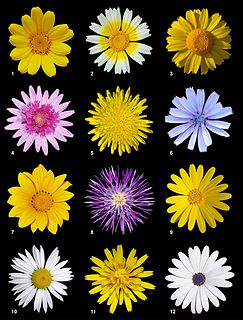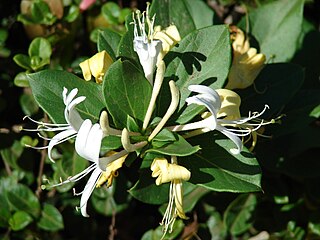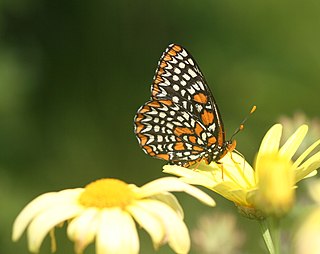 W
WA flower, sometimes known as a bloom or blossom, is the reproductive structure found in flowering plants. The biological function of a flower is to facilitate reproduction, usually by providing a mechanism for the union of sperm with eggs. Flowers may facilitate outcrossing resulting from cross-pollination or allow selfing when self-pollination occurs.
 W
WAn inflorescence is a group or cluster of flowers arranged on a stem that is composed of a main branch or a complicated arrangement of branches. Morphologically, it is the modified part of the shoot of seed plants where flowers are formed. The modifications can involve the length and the nature of the internodes and the phyllotaxis, as well as variations in the proportions, compressions, swellings, adnations, connations and reduction of main and secondary axes. One can also define an inflorescence as the reproductive portion of a plant that bears a cluster of flowers in a specific pattern.
 W
WAestivation or estivation is the positional arrangement of the parts of a flower within a flower bud before it has opened. Aestivation is also sometimes referred to as praefoliation or prefoliation, but these terms may also mean vernation: the arrangement of leaves within a vegetative bud.
 W
WIn botany, blossoms are the flowers of stone fruit trees and of some other plants with a similar appearance that flower profusely for a period of time in spring.
 W
WA flower car is a type of vehicle used in the funeral industry of the United States. It is used to carry flowers for the burial service, or sometimes to carry the coffin under a bed of flowers. Built on the same commercial chassis as a hearse, the flower car has half-height rear bodywork on the rear similar to a pickup truck bed. The bed contains a liner to hold the flowers, normally built of stainless steel to resist rust. Some flower cars have a raised, flat tonneau cover across the bed at the top, upon which the flowers sit; the center portion sometimes is designed to raise and lower, hydraulically or by hand. If the flower car is designed to carry a casket, it will be stored under the tonneau cover in the space beneath, behind the opening rear gate.
 W
WFor bees, their forage or food supply consists of nectar and pollen from blooming plants within flight range. The forage sources for honey bees are an important consideration for beekeepers. In order to determine where to locate hives for maximum honey production and brood one must consider the off-season. If there are no honey flows the bees may have to be fed. Bees that are used for commercial pollination are usually fed in the holding yards. Forage is also significant for pollination management with other bee species. Nectar contains sugars that are the primary source of energy for the bees' wing muscles and for heat for honey bee colonies for winter. Pollen provides the protein and trace minerals that are mostly fed to the brood in order to replace bees lost in the normal course of life cycle and colony activity.
 W
WThe term pollen source is often used in the context of beekeeping and refers to flowering plants as a source of pollen for bees or other insects. Bees collect pollen as a protein source to raise their brood. For the plant, the pollinizer, this can be an important mechanism for sexual reproduction, as the pollinator distributes its pollen. Few flowering plants self-pollinate; some can provide their own pollen, but require a pollinator to move the pollen; others are dependent on cross pollination from a genetically different source of viable pollen, through the activity of pollinators. One of the possible pollinators to assist in cross-pollination are honeybees. The article below is mainly about the pollen source from a beekeeping perspective.
 W
WA nectar source is a flowering plant that produces nectar as part of its reproductive strategy. These plants create nectar, which attract pollinating insects and sometimes other animals such as birds.
 W
WA pedicel is a stem that attaches a single flower to the inflorescence. Such inflorescences are described as pedicellate.
 W
WIn botany, a peduncle is a stalk supporting an inflorescence or a solitary flower, or, after fecundation, an infructescence or a solitary fruit. The peduncle sometimes has bracts at nodes. The main axis of an inflorescence above the peduncle is the rachis. There are no flowers on the peduncle but there are flowers on the rachis.
 W
WA pollen-presenter is an area on the tip of the style in flowers of plants of the family Proteaceae on which the anthers release their pollen prior to anthesis. To ensure pollination, the style grows during anthesis, sticking out the pollen-presenter prominently, and so ensuring that the pollen easily contacts the bodies of potential pollination vectors such as bees, birds and nectarivorous mammals. The systematic depositing of pollen on the tip of the style implies the plants have some strategy to avoid excessive self-pollination.
 W
WAn abortive flower is a flower that has a stamen but an under developed, or no pistil. It falls without producing fruit or seeds, due to its inability to fructify. Flowers require both male and female organs to reproduce, and the pistils and ovary serve as female organs, while the stamens are considered male organs.
 W
WArtificial plants are imitations of natural plants used for commercial or residential decoration. They are sometimes made for scientific purposes . Artificial plants vary widely from mass-produced varieties that are distinguishable from real plants by casual observation to highly detailed botanical or artistic specimens.
 W
WGeertgen Wyntges, was a Dutch Golden Age flower painter who assisted the painter Maria van Oosterwijck.
 W
WA blue rose is a flower of the genus Rosa that presents blue-to-violet pigmentation instead of the more common red, white, or yellow. Blue roses are often used to symbolize mystery or attaining the impossible. However, because of genetic limitations, they do not exist in nature. In 2004, researchers used genetic modification to create roses that contain the blue pigment delphinidin.
 W
WA cherry blossom is a flower of many trees of genus Prunus or Prunus subg. Cerasus. They are also known as Japanese cherry and Sakura. They generally refer to ornamental cherry trees, not to be confused with cherry trees that produce fruit for eating. It is considered the national flower of Japan.
 W
WA damned or damn yellow composite (DYC) is any of the numerous species of composite flowers that have yellow flowers and can be difficult to tell apart in the field. It is a jocular term, and sometimes reserved for those yellow composites of no particular interest. Notable individuals who referred to these flowers as "DYCs" include Oliver Sacks and Lady Bird Johnson.
 W
W"Double-flowered" describes varieties of flowers with extra petals, often containing flowers within flowers. The double-flowered trait is often noted alongside the scientific name with the abbreviation fl. pl.. The first abnormality to be documented in flowers, double flowers are popular varieties of many commercial flower types, including roses, camellias and carnations. In some double-flowered varieties all of the reproductive organs are converted to petals — as a result, they are sexually sterile and must be propagated through cuttings. Many double-flowered plants have little wildlife value as access to the nectaries is typically blocked by the mutation.
 W
WAn ephemeral plant is one marked by short life cycles. The word ephemeral means transitory or quickly fading. In regard to plants, it refers to several distinct growth strategies. The first, spring ephemeral, refers to perennial plants that emerge quickly in the spring and die back to their underground parts after a short growth and reproduction phase. Desert ephemerals are plants which are adapted to take advantage of the short wet periods in arid climates. Mud-flat ephemerals take advantage of short periods of low water. In areas subjected to recurring human disturbance, such as plowing, weedy ephemerals are very short-lived plants whose entire life cycle takes less than a growing season. In each case, the species has a life cycle timed to exploit a short period when resources are freely available.
 W
WFloral color change occurs in flowers in a wide range of angiosperm taxa that undergo a color change associated with their age, or after successful pollination.
 W
WFloral diagram is a graphic representation of flower structure. It shows the number of floral organs, their arrangement and fusion. Different parts of the flower are represented by their respective symbols. Floral diagrams are useful for flower identification or can help in understanding angiosperm evolution. They were introduced in the late 19th century and are generally attributed to A. W. Eichler.
 W
WA Floral formula is a notation for representing the structure of particular types of flowers. Such notations use numbers, letters and various symbols to convey significant information in a compact form. They may represent the floral form of a particular species, or may be generalized to characterize higher taxa, usually giving ranges of numbers of organs. Floral formulae are one of the two ways of describing flower structure developed during the 19th century, the other being floral diagrams. The format of floral formulae differs according to the tastes of particular authors and periods, yet they tend to convey the same information.
 W
WFloral scent or flower scent is composed of all the volatile organic compounds (VOCs), or aroma compounds, emitted by floral tissue. Floral scent is also referred to as aroma, fragrance, floral odour or perfume. Flower scent of most flowering plant species encompass a diversity of VOCs, sometimes up to several hundred different compounds. The primary functions of floral scent are to deter herbivorous and especially florivorous insects, and to attract pollinators. Floral scent is one of the most important communication channels mediating plant-pollinator interactions, along with visual cues.
 W
WA flower bouquet is a collection of flowers in a creative arrangement. Flower bouquets can be arranged for the decor of homes or public buildings, or may be handheld. Handheld bouquets are classified by several different popular shapes and styles, including nosegay, crescent, and cascading bouquets. Flower bouquets are often given for special occasions such as birthdays, anniversaries or funerals. They are also used extensively in weddings as well as Olympics Medal Ceremonies. Bouquets arranged in vases or planters for home decor can be arranged in either traditional or modern styles. Symbolism may be attached to the types of flowers used, according to the culture.
 W
W"Illegal flower tribute" is an Internet meme that emerged after Google's announcement of a possible exit from Mainland China in January 2010. On 12 January 2010, Google posted an article on its official Blogspot blog, entitled "A New Approach to China", in which it disclosed its decision to end compliance with the Internet censorship in China at Google.cn, citing recent politically motivated hacker attacks from China on Gmail accounts of Chinese human rights activists as its primary concern. Google also announced it negotiated with the Chinese government on this issue, but no agreement or consensus on a non-censoring search engine was made, so traffic to Google.cn was re-routed to Google.com.hk.
 W
WThe National Flower of the Republic of China was officially designated as the plum blossom by the Executive Yuan of the Republic of China on July 21, 1964. The plum blossom, known as the meihua, is a symbol for resilience and perseverance in the face of adversity, because plum blossoms often bloom most vibrantly even amidst the harsh winter snow. As the plum tree can usually grow for a long time, ancient trees are found throughout China. Huangmei county in Hubei features a 1,600-year-old plum tree from the Jin Dynasty which is still flowering. The three stamens represents Dr. Sun Yat-sen's Three Principles of the People, while the five petals symbolize the five branches of the government: Executive Yuan, Legislative Yuan, Judicial Yuan, Examination Yuan and Control Yuan. The flower has also been proposed to be one of the national flowers for the People's Republic of China.
 W
WNectar is a sugar-rich liquid produced by plants in glands called nectaries or nectarines, either within the flowers with which it attracts pollinating animals, or by extrafloral nectaries, which provide a nutrient source to animal mutualists, which in turn provide herbivore protection. Common nectar-consuming pollinators include mosquitoes, hoverflies, wasps, bees, butterflies and moths, hummingbirds, honeyeaters and bats. Nectar plays a crucial role in the foraging economics and evolution of nectar-eating species; for example, nectar foraging behavior is largely responsible for the divergent evolution of the African honey bee, A. m. scutellata and the western honey bee.
 W
WA nosegay, posy, or tussie-mussie is a small flower bouquet, typically given as a gift. They have existed in some form since at least medieval times, when they were carried or worn around the head or bodice. Doilies are traditionally used to bind the stems in these arrangements. Alternatively, "posy holders", available in a variety of shapes and materials, enable the wearing of these arrangements "at the waist, in the hair, or secured with a brooch".
 W
WOshibana (押し花) is the art of using pressed flowers and other botanical materials to create an entire picture from these natural elements. Such pressed flower art consists of drying flower petals and leaves in a flower press to flatten and exclude light and moisture. These elements are then used to "paint" an artistic composition. The origin of this art form has been traced to 16th century Japan, but it is now practiced worldwide. The resulting artwork is referred to as an oshibana.
 W
WPicotee describes flowers whose edge is a different colour than the flower's base colour. The word originates from the French picoté, meaning 'marked with points'.
 W
WPollination syndromes are suites of flower traits that have evolved in response to natural selection imposed by different pollen vectors, which can be abiotic or biotic, such as birds, bees, flies, and so forth through a process called pollinator-mediated selection. These traits include flower shape, size, colour, odour, reward type and amount, nectar composition, timing of flowering, etc. For example, tubular red flowers with copious nectar often attract birds; foul smelling flowers attract carrion flies or beetles, etc.
 W
WOshibana (押し花) is the art of using pressed flowers and other botanical materials to create an entire picture from these natural elements. Such pressed flower art consists of drying flower petals and leaves in a flower press to flatten and exclude light and moisture. These elements are then used to "paint" an artistic composition. The origin of this art form has been traced to 16th century Japan, but it is now practiced worldwide. The resulting artwork is referred to as an oshibana.
 W
WA pseudanthium is an inflorescence that resembles a flower. The word is sometimes used for other structures that are neither a true flower nor a true inflorescence. Examples of pseudanthia include flower head, composite flower, or capitulum, which are special types of inflorescences in which anything from a small cluster to hundreds or sometimes thousands of flowers are grouped together to form a single flower-like structure. Pseudanthia take various forms. The real flowers are generally small and often greatly reduced, but the pseudanthium itself can sometimes be quite large.
 W
WA raceme or racemoid is an unbranched, indeterminate type of inflorescence bearing pedicellate flowers along its axis. In botany, an axis means a shoot, in this case one bearing the flowers. In indeterminate inflorescence-like racemes, the oldest flowers are borne towards the base and new flowers are produced as the shoot grows, with no predetermined growth limit. A plant that flowers on a showy raceme may have this reflected in its scientific name, e.g. Cimicifuga racemosa. A compound raceme, also called a panicle, has a branching main axis. Examples of racemes occur on mustard and radish plants.
 W
WIn plant biology, ramiflory is the production of fruit and flowers on the woody branches of a plant, formed in a previous season. The corresponding condition for the trunk of the plant is known as cauliflory.
 W
WRemontancy is the ability of a plant to flower more than once during the course of a growing season or year. It is a term applied most specifically to roses, and roses possessing this ability are called "repeat flowering" or remontant. The term originated in the nineteenth century from the French verb remonter or 'coming up again'. Roses which lack this ability are termed "summer flowering", "once flowering" or non-remontant. Few wild rose species possess remontancy; notable exceptions being Rosa chinensis, Rosa rugosa and Rosa fedtschenkoana.
 W
WA superbloom is a rare desert botanical phenomenon in which an unusually high proportion of wildflowers whose seeds have lain dormant in desert soil germinate and blossom at roughly the same time. The phenomenon is associated with an unusually wet rainy season. The term may have developed as a label in the 1990s.
 W
WThe Vaijayanti (Vyjayanti) or Vaijayantimala or Vana-mala is a theological flower, offered to Krishna and Vishnu in worship as a garland, "Vaijayanti-mala". Literally meaning, "the garland of victory",: An Vaijayanti-mala also finds mention in Vishnu sahasranama, a stotra dedicated to Vishnu in the Mahabharata, as vanamali. The garland of victory mentioned in the Mahabharata was made of never-wilting lotuses (1.57.15-16); however, many flowers are currently believed to be the Vaijayanti, including Job's Tears. The latter is sometimes mistaken with the original Vaijayanti. The original Vaijayanti plant looks like long grass and hence is difficult to identify, till flowering or seeds start growing in it.
 W
WA wildflower is a flower that grows in the wild, meaning it was not intentionally seeded or planted. The term implies that the plant probably is neither a hybrid nor a selected cultivar that is in any way different from the way it appears in the wild as a native plant, even if it is growing where it would not naturally. The term can refer to the flowering plant as a whole, even when not in bloom, and not just the flower.